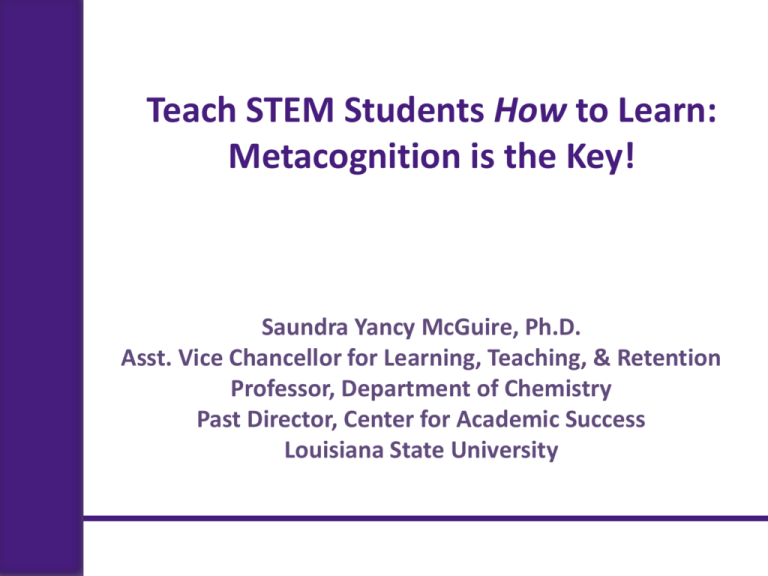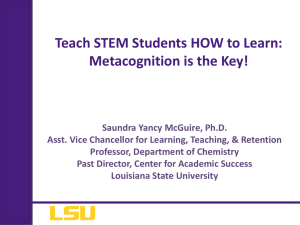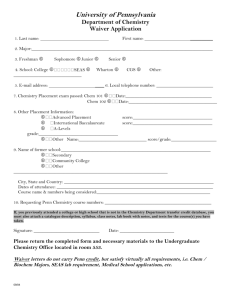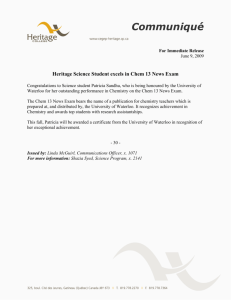
Teach STEM Students How to Learn:
Metacognition is the Key!
Saundra Yancy McGuire, Ph.D.
Asst. Vice Chancellor for Learning, Teaching, & Retention
Professor, Department of Chemistry
Past Director, Center for Academic Success
Louisiana State University
2004-2005 National College Learning Center Association
Frank L. Christ Outstanding Learning Center Award
Outline
• Examples of Results of Teaching Students
Metacognitive Strategies
• Definition of Metacognition
• Exercise Demonstrating Efficacy of
Metacognitive Strategies
• Bloom’s Taxonomy & The Study Cycle
• Impact of Teaching Metacognitive
Strategies During Class Sessions
• Conclusion
The Story of Four Students
• Robert, first year chemistry student
42, 100, 100, 100
A in course
• Dana, first year physics student
80, 54, 91, 97, 90 (final) A in course
• Aaron, first year biology student
78, 92
A in course
• Cici*, first year chemistry student
55, 60, 105**
A in course
* Learned strategies from chem instructor
** Due to bonus points
Four Students in Professor Isiah Warner’s
Fall 2005 Analytical Chemistry Class
Test 1
Test 2
Test 3
Final
Class
Average Student 1 Student 2 Student 3 Student 4
76
65
67
70
83
52
67
65
46
55
72
61
68
68
65
78
107
88
88
90
Date of Final Exam:
December 14, 2005
Meeting with Student No. 1:
December 12, 2005
Meeting with Student Nos. 2 & 4: December 2, 2005
Meeting with Student No. 3:
December 8, 2005
The final was worth 100 points with a 10 bonus question.
How’d They Do It?
They became expert learners
by using metacognition!
They learned to think about their own thinking,
and they studied to LEARN,
not just to make the grade!
Metacognition*
The ability to:
• think about one’s own thinking
• be consciously aware of oneself as a
problem solver
• monitor and control one’s mental
processing (e.g. “Am I understanding this
material?”)
• accurately judge one’s level of learning
*term coined by Flavell in 1976
Bransford, J.D., Brown, A.L., Cocking, R.R. (Eds.), 2000. How people learn: Brain,
Mind, Experience, and School. Washington, DC: National Academy Press.
Why don’t most students know
how to learn or how to study?
According to data from the
entering class of 2010...*
• It wasn’t necessary in high school
- 63% of 2010 entering first year
students spent less than six hours per
week doing homework in 12th grade.
- More than 48% of these students said
they graduated from high school with
an “A” average.*
• Students’ confidence level is high
- 71.2 % believe their academic ability is
above average or in the highest 10
percent among people their age
*2010 Higher Education Research Institute Study
Approximately how many hours per week did you
have to study to make A’s and B’s in high school?
1.
2.
3.
4.
5.
6.
7.
0–4
5–9
10 – 14
15 – 19
20 – 24
25 – 29
30 or more
62%
17%
14%
7%
1
2
3
4
0%
0%
0%
5
6
7
Center
for Academic Success
Transform Learning. Maximize Performance.
How do you think most students would
answer the following questions?
What did most of your teachers in
high school do the day before the test?
What did they do during this activity?
What grade would you have made on
the test if you went to class only on
the day before the test?
Faculty Must Help Students
Make the Transition to College
Help students identify and close “the gap”
current behavior
Appropriate behavior
current grades
desired grades
Reflection Questions
• What’s the difference, if any, between
studying and learning? Which, if either, is
more enjoyable? Why?
• For which task would you study harder?
– Make an A on the test
– Teach the material to the class
Cause of Fast and Dramatic Increase?
It’s all about the strategies, and
getting them to engage their brains!
Counting Vowels in 45 seconds
How accurate are you?
Dollar Bill
Dice
Tricycle
Four-leaf Clover
Hand
Six-Pack
Seven-Up
Octopus
Cat Lives
Bowling Pins
Football Team
Dozen Eggs
Unlucky Friday
Valentine’s Day
Quarter Hour
How many words or phrases
do you remember?
Let’s look at the words again…
What are they arranged according to?
Dollar Bill
Dice
Tricycle
Four-leaf Clover
Hand
Six-Pack
Seven-Up
Octopus
Cat Lives
Bowling Pins
Football Team
Dozen Eggs
Unlucky Friday
Valentine’s Day
Quarter Hour
NOW, how many words or phrases
do you remember?
What were two major differences
between the first attempt
and the second attempt?
1. We knew what the task was
2. We knew how the information
was organized
What we know about learning
• Active learning is more lasting than passive learning
-- Passive learning is an oxymoron*
• Thinking about thinking is important
– Metacognition**
• The level at which learning occurs is important
– Bloom’s Taxonomy***
*Cross, Patricia, “Opening Windows on Learning” League for Innovation in the
Community College, June 1998, p. 21.
** Flavell, John, “Metacognition and cognitive monitoring: A new area of cognitive–
developmental inquiry.” American Psychologist, Vol 34(10), Oct 1979, 906-911.
*** Bloom Benjamin. S. (1956). Taxonomy of Educational Objectives, Handbook I: The
Cognitive Domain. New York: David McKay Co Inc.
Bloom’s Taxonomy
Anderson & Krathwohl, 2001
http://projects.coe.uga.edu/epltt/index.php?title=Bloom's_Taxonomy
Combining information to
form a unique product;
requires creativity and
originality.
Evaluation
Synthesis
Using information to solve
problems; transferring
abstract or theoretical ideas
to practical situations.
Identifying connections and
relationships and how they
apply.
Application
Comprehension
Restating in
your own words;
paraphrasing,
summarizing,
translating.
Knowledge
Louisiana State University Center for Academic Success B-31 Coates Hall 225-578-2872 www.cas.lsu.edu
High School
Memorizing verbatim
information. Being able to
remember, but not
necessarily fully
understanding the
material.
Identifying
components;
determining
arrangement, logic,
and semantics.
Undergraduate
Analysis
Making decisions and
supporting views;
requires
understanding of
values.
Graduate School
Bloom’s
Taxonomy
This pyramid depicts the different levels of thinking we use when learning.
Notice how each level builds on the foundation that precedes it. It is
required that we learn the lower levels before we can effectively use the
skills above.
When we teach students about
Bloom’s Taxonomy…
They GET it!
At what level of Bloom’s did you have to
operate to make A’s or B’s in high school?
35%
1.
2.
3.
4.
5.
6.
Knowledge
Comprehension
Application
Analysis
Synthesis
Evaluation
25%
21%
13%
1
2
3
4
3%
3%
5
6
At what level of Bloom’s do you think you’ll
need to be to make an A in college?
35%
1.
2.
3.
4.
5.
6.
Knowledge
Comprehension
Application
Analysis
Synthesis
Evaluation
23%
15%
14%
7%
6%
1
2
3
4
5
6
How do we teach students to move
higher on Bloom’s Taxonomy?
Teach them the Study Cycle*
*adapted from Frank Christ’s PLRS system
The Study Cycle
34
Reflect
Review
Preview
Preview before class – Skim the chapter, note headings and boldface words,
review summaries and chapter objectives, and come up with questions
you’d like the lecture to answer for you.
Attend
Attend class – GO TO CLASS! Answer and ask questions and take meaningful
notes.
4
Reflect
Review
Study
Assess
Review after class – As soon after class as possible, read notes, fill in gaps
and note any questions.
Study – Repetition is the key. Ask questions such as ‘why’, ‘how’, and ‘what if’.
• Intense Study Sessions* - 3-5 short study sessions per day
• Weekend Review – Read notes and material from the week to make
connections
Assess your Learning – Periodically perform reality checks
• Am I using study methods that are effective?
• Do I understand the material enough to teach it to others?
*Intense Study Sessions
Decide what you want to accomplish in your study session
1
Set a Goal
2
Study with Focus
(30-50 min)
Interact with material- organize, concept map, summarize, process, re-read, fill-in notes,
reflect, etc.
3
Reward Yourself
(10-15 min)
Take a break– call a friend, play a short game, get a snack
4
Review
(1-2 min)
(5 min)
Go over what you just studied
Center for Academic Success
B-31 Coates Hall ▪ 225.578.2872 ▪www.cas.lsu.edu
Concept maps
facilitate development
of higher order thinking skills
And there are many different forms
of
concept maps…Center for Academic Success
Transform Learning. Maximize Performance.
Chapter Map
Title of Chapter
Primary Headings
Subheadings
Secondary Subheadings
Center
for Academic Success
Transform Learning. Maximize Performance.
Compare and Contrast
Concept #1
Concept #2
How are they similar?
How are they different?
Center
for Academic Success
Transform Learning. Maximize Performance.
LSU Analytical Chemistry Graduate Student’s
Cumulative Exam Record
2004 – 2005
2005 – 2006
9/04
Failed
10/05
Passed
10/04
Failed
11/05
Failed
12/05
Passed best in group
1/06
Passed
2/06
Passed
Began work
with CAS and
the Writing
Center in
October 2005
11/04
Failed
12/04
Failed
1/05
Passed
2/05
Failed
3/06
Failed
3/05
Failed
4/06
Passed last one!
4/05
Failed
5/06
N/A
Dr. Algernon Kelley, December 2009
The Impact of Using Metacognitive Strategies
“Without these strategies, I probably would have
gotten a C in chemistry. You showed us the first week
a way to get an A in the class and I knew that was
going to be my only way to achieve that A. I was
planning on just studying before the test.
But when you stressed how important it was to
preview and review and study 2 hours a day or so, I
was in shock, but I followed the guideline and got
myself an A. So, I would like to thank you, because
without these strategies, I probably would have done
terribly in Chemistry.”
Fall 2009 First semester chemistry
student
… and from a Spring 2011 student
“…Personally, I am not so good at chemistry and
unfortunately, at this point my grade for that class is
reflecting exactly that. I am emailing you inquiring about
a possibility of you tutoring me.”
April 6, 2011
“I made a 68, 50, 50, 87, 87, and a 97 on my final. I
ended up earning a 90 in the course, but I started with a
60. I think what I did different was make sidenotes in
each chapter and as I progressed onto the next chapter I
was able to refer to these notes. I would say that in
chemistry everything builds from the previous topic”
May 13, 2011
Semester GPA: 3.8
… and from the perspective of a faculty member
who learned metacognitive strategies as a student
“…I am happy to report to you that many of my
students are using the study cycle and all of the
outcomes are positive.
In summary, students who were failing all of their
classes, including my course and in their final
semester before being removed from the university
are now the top students in their respective
classes.
I am so proud of these students. Many of the
students stated to me that they will continue to use
the study cycle.....”
October 15, 2010
Algernon Kelley, Xavier University Chemistry Instructor
The story of General Chemistry I
in 2008, 2009, 2010, and 2011:
what happens when we teach
metacognitive strategies to an
entire class?*
*Cook, Elzbieta and Saundra McGuire. 2011. “Is less
more? How much, when and how to teach learning
strategies in General Chemistry courses”. Poster
presented at the spring national meeting of the
American Chemical Society, Anaheim, CA.
What was done in 2008 and 2009
in General Chemistry I
In 2008 and 2009, students lacking math skills
(Math ACT score < 24) were allowed to take Gen
Chem I.
However, they had to
• co-enroll in College Algebra
• enroll in a 1-credit hour supplemental chemistry
course (Chem 1200), in which study and learning
strategies, as well as problem solving skills, were
taught throughout the semester in a weekly 75
minute review session.
Gen. Chem. I Results for Students
with MATH ACT score < 24
Before CHEM 1200
2006
Cook
2007
Combined
Instructors
Cook
Combined
Instructors
%ABC
47
54
46
47
%DFW
53
46
54
53
Performance in Gen Chem I based on
Chem 1200 attendance
2008
1200 (≥75% sessions)
2009
No-1200
(N = 191; 86%)
1200 (≥75% sessions)
No-1200
(N = 157; 64%)
A
B
C
D
F
W
15.71
29.84
32.98
18.32
3.14
−
33.05
26.87
15.78
8.96
8.10
7.25
12.01
24.20
43.95
12.73
5.10
1.91
29.82
25.06
21.55
6.02
8.77
8.77
ABC
DFW
78.53
21.47
75.69
24.31
80.25
19.75
76.44
23.55
What was done in 2010 and 2011?
• No students with ACT math scores < 24
were allowed in Gen Chem I
• No Chem 1200 was offered.
• But, study and learning strategies were
taught in one 50-min class immediately
after the results of Exam 1 were
announced.
Fall 2010 chain of events…
Aug. 23: 657 students were enrolled at the start of the course
Sept. 25: 632 students took Exam 1:
• 123 (19.5%) students failed Exam 1
• 86 students failed Exam 1 but stayed in the course
Sept. 27: 461 students attended McGuire’s talk; 156 did not
Oct. 20: 617 students took Exam 2
Exam 1 Avg.:
Attended
72.35%
Absent
70.11%
Improvement on Exam 2:
Decline on Exam 2:
No change on Exam 2:
230 (50%)
127 (27.5%)
104 (22.5%)
55 (35%)
70 (45%)
31 (20%)
Fall 2010 chain of events…
Aug. 23: 657 students were enrolled at the start of the semester
Sept. 25: 461 students attended McGuire’s talk; 156 did not
Oct. 20: 617 students took Exam 2
Exam 1 Avg.:
Attended
72.35%
Absent
70.11%
Exam 2 Avg.:
76.01%
68.74%
Exam 1 to Exam 2 Change
+3.66%
-1.37%
Net change:
+
+5.03%
One 50-min presentation on study and learning strategies resulted in
an improvement of over 1/2 of a letter grade
Performance in Gen Chem I in 2010
Based on One Learning Strategies Session
Exam 1 Avg.:
Exam 2 Avg.:
Final course Avg*.:
Final Course Grade:
Attended
72.35%
76.01%
82.48%
B
Absent
70.11%
68.74%
72.61%
C
Even one 50-min presentation on study and learning
strategies may mean an improvement of one full letter grade!
Note: 15% of the final course grade was determined by homework;
students could also earn ~5% for extra credit activities.
Fall 2011 chain of events…
Aug. 22: 718 students were enrolled at the start of the semester
Sept. 23: 502 students attended McGuire’s talk; 216 did not
Oct. 11: 695 students took Exam 2
Exam 1 Avg.:
Attended
71.65%
Absent
70.45%
Entire Class
71.30%
Exam 2 Avg.:
77.18%
68.90%
74.74%
Exam 1 to Exam 2 Change
+5.53%
-1.55%
+3.34%
Net change:
+7.08%
One 50-min presentation on study and learning strategies resulted in
an improvement of over 2/3 of a letter grade
Performance in Gen Chem I in 2011
Based on One Learning Strategies Session
Exam 1 Avg.:
Exam 2 Avg.:
Final course Avg*.:
Final Course Grade:
Attended
71.65%
77.18%
81.60%
B
Absent
70.45%
68.90%
70.43%
C
The one 50-min presentation on study and learning strategies
again resulted in an improvement of one full letter grade!
Note: 15% of the final course grade was determined by homework;
students could also earn ~5% for extra credit activities.
Performance in Organic Chem I Based on
One Learning Strategies Session
Fall 2011
Exam 1 Avg.:
Exam 2 Avg.:
Attended
67.95%
71.36%
Absent
74.04%
70.39%
Change
+3.41%
-3.65%
Net Change
+7.06%
One 50-min presentation on study and learning strategies again
resulted in an improvement of over 2/3 of a letter grade on Exam 2
Teaching and Learning Strategies That Work
SCIENCE , VOL 325
4 SEPTEMBER 2009
www.sciencemag.org
ROALD HOFFMANN1*
AND
SAUNDRA Y. MCGUIRE2
1Department
of Chemistry and Chemical Biology, Cornell
University, Baker Laboratory, Ithaca, NY 14853, USA.
2Center
for Academic Success and Department of Chemistry,
Louisiana State University, Baton Rouge, LA 70803, USA.
September-October 2010
Volume 98, Number 5
MARGINALIA
Learning and Teaching Strategies
Roald Hoffmann and Saundra Y. McGuire
Special Note
Please visit the CAS website at
www.cas.lsu.edu.
We have on-line workshops that will introduce
you and your students to effective
metacognitive strategies. Have fun helping
your students learn how to learn!
Saundra McGuire
Additional References
• Bruer, John T. , 2000. Schools For Thought: A Science of Learning
in the Classroom. MIT Press.
• Christ, F. L., 1997. Seven Steps to Better Management of Your
Study Time*. Clearwater, FL: H & H Publishing.
• Cromley, Jennifer, 2000. Learning to Think, Learning to Learn:
What the Science of Thinking and Learning Has to Offer Adult
Education. Washington, DC: National Institute for Literacy.
• Ellis, David, 2006. Becoming a Master Student*. New York:
Houghton-Mifflin.
• McGuire, Saundra, 2004. Teaching Your Students HOW to Learn
Chemistry. In D. Bunce and C. Muzzi (Eds.), Survival Handbook for
the New Chemistry Instructor. Upper Saddle River, NJ: Pearson
Prentice Hall.
• Nilson, Linda, 2004. Teaching at It’s Best: A Research-Based
Resource for College Instructors. Bolton, MA: Anker Publishing
Company.
• Pierce, William, 2004. Metacognition: Study Strategies, Monitoring,
and Motivation.
http://academic.pg.cc.md.us/~wpeirce/MCCCTR/metacognition.htm
*Excellent student references
Acknowledgments
• Dr. Elzbieta Cook, General Chem I Instructor
• Faculty in the LSU Chemistry Department
• Prof. Isiah Warner and the Office of Strategic
Initiatives
• Sarah Baird & LSU Center for Academic Success
• National College Learning Center Association
• All of the students who changed their attitudes
and behaviors and showed me what was
possible!
• The National Science Foundation








